#Weyhe Gallery
Explore tagged Tumblr posts
Text

Mabel Dwight, Greetings from the House of Weyhe, 1928. Lithograph.
The Weyhe Gallery on Lexington Avenue was a nexus of printmaking in the 1920s and 30s. Director Carl Zigrosser championed the work of many artists, including Mabel Dwight and Howard Cook. Every year, the Weyhe Gallery commissioned one of the artists it represented to produce a greeting card for the holidays. This was Mabel Dwight’s card design for 1928. She depicted Zigrosser wearing a bow tie and leaning against the bookcase.
Dwight was a printmaker who specialized in portraying scenes of everyday life in Manhattan. Zigrosser said of her, " "Her work is imbued with pity and compassion, a sense of irony, and the understanding that comes of deep experience." Between the late 1920s and the early 1940s, she achieved both popularity and critical success. In 1936, Prints magazine named her one of the best living printmakers and a critic at the time said she was one of the foremost lithographers in the United States.
Photo: Museum of Modern Art
#vintage New York#1920s#Mabel Dwight#House of Weyhe#art gallery#Weyhe Gallery#women artists#female artists#printmaking#holiday cards#Christmas cards#Carl Zigrosser
26 notes
·
View notes
Text
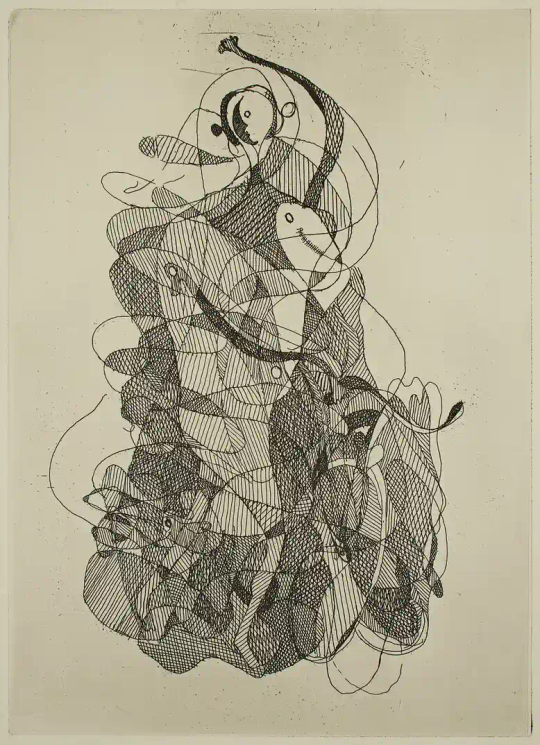
Georges Braque, La danse (1934)
Detroit Institute of Arts
6 notes
·
View notes
Text




Adolph Dehn, The Great God Pan (1940)
Over at the Philadelphia Museum of Art site you can see the multiple layers of this screen print by Adolph Dehn of some nuns painting the god Pan. Pretty great.
This lithograph is also great:

I'd never heard of Dehn's work before — he was a friend of the great Wanda Gág, whose book Millions of Cats I read to my kids “millions and billions and trillions” of times.
He did a lot of nun pieces:



Here's a biography of Dehn from The Smithsonian:
Dehn's satirical prints of European and New York scenes were the product of an unconventional Minnesota upbringing and an iconoclastic eye. The son of a feminist, socialist mother and an atheist, anarchist father, he was not destined for a quiet life. He studied at the Minneapolis Art Institute and the Art Students League in New York, after which he was imprisoned as a conscientious objector during World War I. On his release Dehn took odd jobs and made his way to Europe, where his work as a magazine illustrator supported him and his Russian immigrant wife in their travels. While in Europe Dehn was a critical observer of the social scene, especially in Vienna and Berlin, and a light-hearted painter of park scenes and landscapes. In 1930, after his return from Europe, his work, on both European and New York subjects, was shown at the Weyhe Gallery in New York City. The critical response was good, but sales were only moderate. In the mid-1930s, Dehn began to paint watercolor landscapes, which proved immensely popular. As a result, new commercial opportunities opened, including travels through the United States, Mexico, and Venezuela. His fame led to offers to teach and then to work for the Navy during World War II. Throughout the forties, fifties, and sixties, Dehn and his wife traveled around the world, doing commercial work and lithography. His work became less satirical and more fanciful, and he experimented with new graphic techniques. He died of a heart attack in 1968 while planning new trips, beginning a book, and organizing a retrospective.
See more of his (non-nun) work here.
22 notes
·
View notes
Text

1928 Weyhe Gallery Bookshop. located at 794 Lexington Avenue. Art by Mabel Dwight. From New York City History and Memories, FB.
29 notes
·
View notes
Text

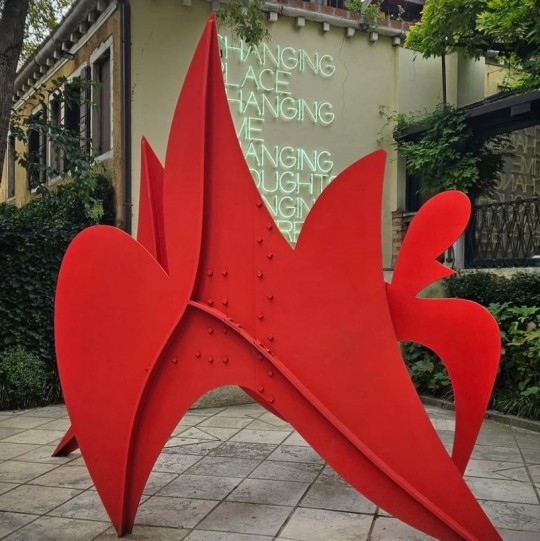

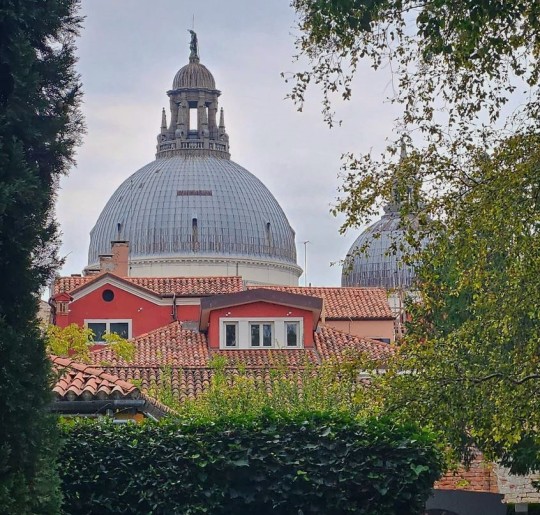
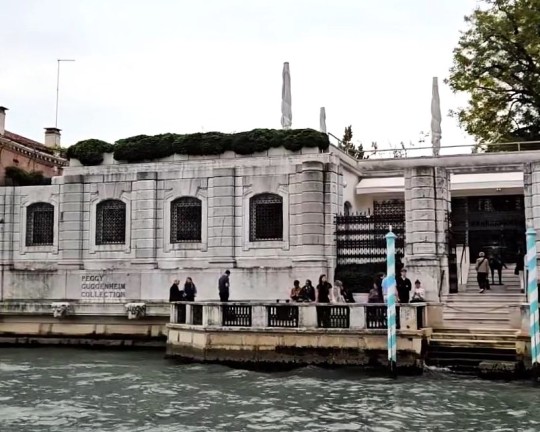

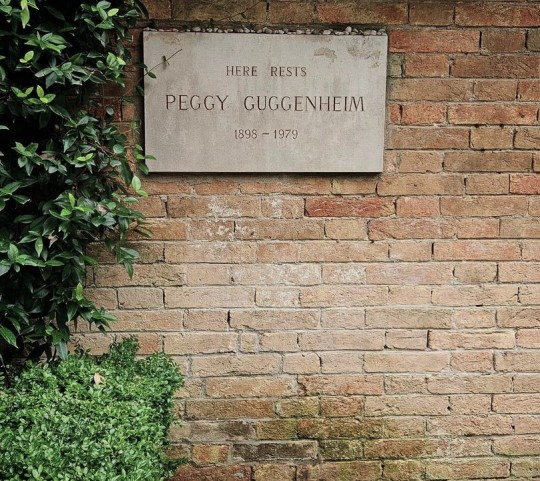
seen at Peggy's place (October 2024)
photos: optikes
Maurizio Nannucci was born in Florence on April 20, 1939. He studied at Florence’s Fine Art Academy and in Berlin before working for many years with experimental theater groups as a set designer. During the first half of the 1960s, he consolidated the basic elements of what would become his visual language by exploring the relationship between art, language, and image, and by creating the first Dattilogrammi, in which words reclaim their strength as symbols. At the same time he was in contact with Fluxus artists, developed an interest for visual poetry, and collaborated with the studio “S 2F M” (Studio di Fonologia Musicale, Florence) to produce electronic music. Nannucci focused on using voices and words to produce sound installations.
In 1967, during his first solo exhibition at the Centro Arte Viva, Trieste, he presented his first neon light texts, thus emphasizing the temporary quality of writing and not the material quality of objects. In 1968 he founded the Exempla publishing house in Florence and Zona Archives Edizioni, both of which published books and catalogues on artists like John Armleder, Robert Filliou, Ian Hamilton Finlay, James Lee Byars, and Sol LeWitt. Nannucci believes that publications and multiples are themselves manifestations of a type of artistic practice that considers art a mental process, one that can be applied to the mass production of everyday objects in order to unify divergent threads in art. The art object may lose its uniqueness, but it gains presence and new freedom.
During the 1990s the artist renewed his interest in the relationship between works of art, architecture, and urban landscape by collaborating with the architects Auer & Weber, Mario Botta, Massimiliano Fuksas, and Renzo Piano. Some of his permanent installations can be seen at the Auditiorium of the Parco Della Musica and Fiumicino airport, both in Rome, and at the Bibliothek des Deutschen Bundestages, Berlin. Nannucci has been a featured artist at the Venice Biennale several times and has participated in Documenta, Kassel, and the São Paulo, Sydney, Istanbul, and Valencia biennials.
Alexander Calder was born July 22, 1898, in Lawnton, Pennsylvania. In 1919, he received an engineering degree from Stevens Institute of Technology, Hoboken. Calder attended the Art Students League, New York, from 1923 to 1925, studying briefly with Boardman Robinson and John Sloan. As a freelance artist for the National Police Gazette in 1925, he spent two weeks sketching at the circus and developed a particular fascination for the subject. He also made his first wire sculpture in 1925, and the following year he made several constructions of animals and figures with wire and wood.
Calder’s first exhibition of paintings took place in 1926 at the Artist’s Gallery, New York. Later that year, he went to Paris and attended the Académie de la Grande Chaumière. In Paris, he met Stanley William Hayter, exhibited at the 1926 Salon des Indépendants, and began giving performances of his miniature circus. The first show of his wire animals and caricature portraits was held at the Weyhe Gallery, New York, in 1928. That same year, he met Joan Miró, who became his lifelong friend. Subsequently, Calder divided his time between France and the United States. In 1929, the Galerie Billiet gave him his first solo show in Paris. He met Frederick Kiesler, Fernand Léger, and Theo van Doesburg and visited Piet Mondrian’s studio in 1930. Calder began to experiment with abstract sculpture and in 1931 and 1932 introduced moving parts into his works. These moving sculptures were called “mobiles,” while his stationary constructions were to be named “stabiles.”
He exhibited with the Abstraction-Création group in Paris in 1933. In 1943, the Museum of Modern Art, New York, gave him a retrospective. During the 1950s, Calder traveled widely and executed Towers (wall mobiles) and Gongs (sound mobiles). He won the Grand Prize for Sculpture at the 1952 Venice Biennale. Late in the decade, the artist worked extensively with gouache. During this period, he executed numerous major public commissions. In 1964–65, the Solomon R. Guggenheim Museum, New York, presented a Calder retrospective. He began the Totems in 1966 and the Animobiles in 1971, both of which are variations on the standing mobile. A Calder exhibition was held at the Whitney Museum of American Art, New York, in 1976. Alexander Calder died November 11, 1976, in New York.
guggenheim-venice.it
0 notes
Photo

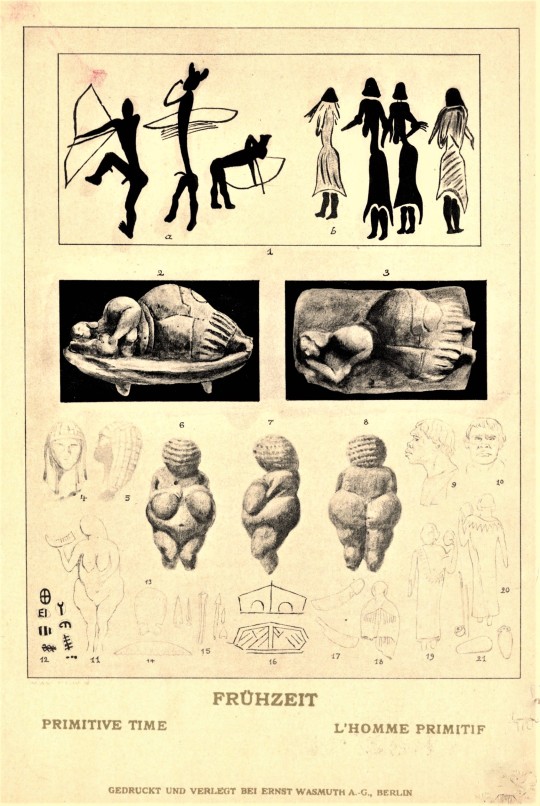
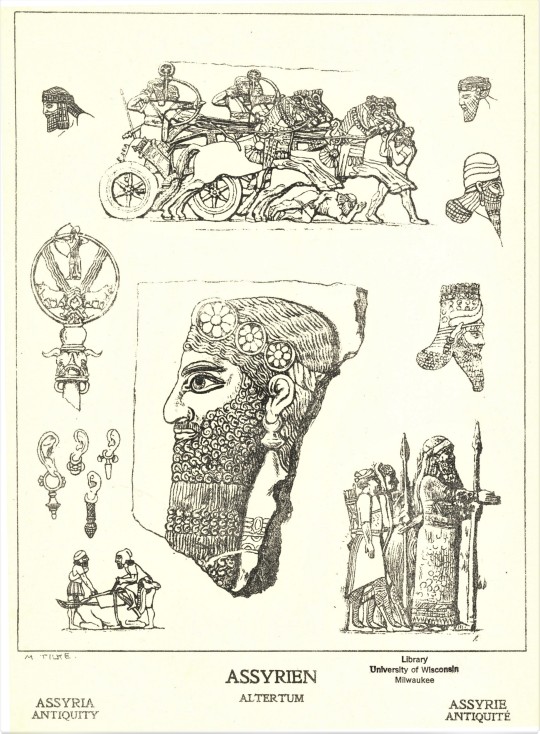
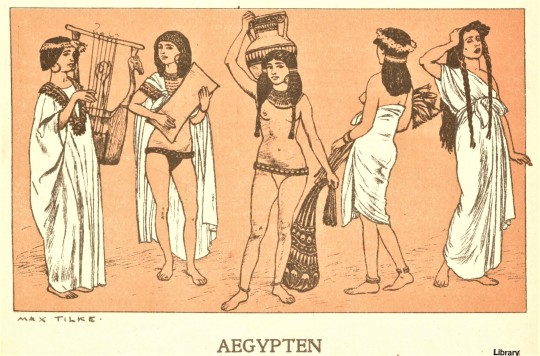


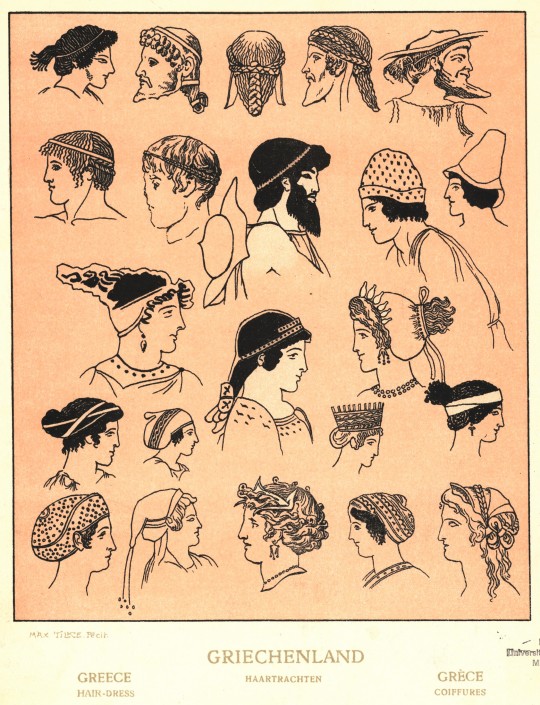

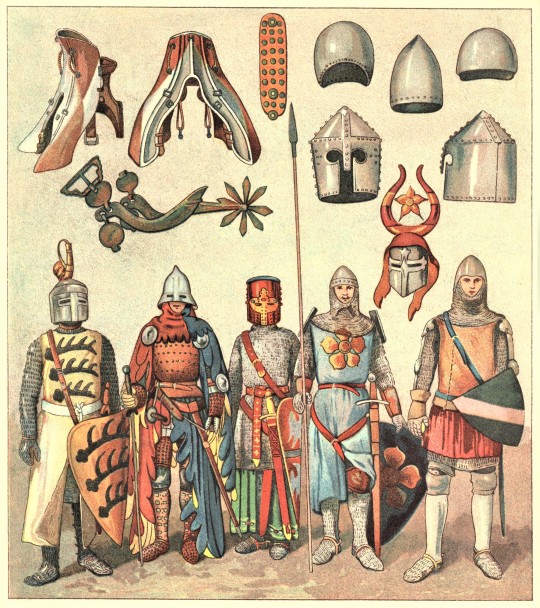
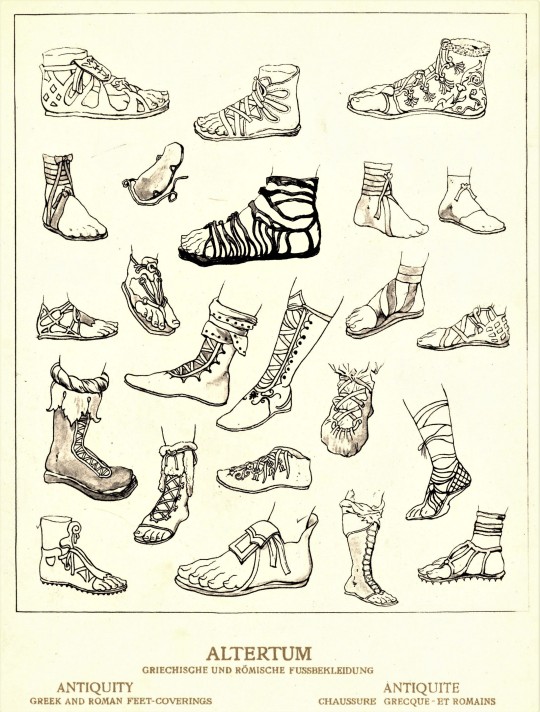
Fashion Friday
For #Fashion Friday, we present German art historian Adolf Rosenberg’s Geschichte des Kostums, a gargantuan, 5-volume collection of historical fashion accompanied by descriptions in German by Eduard Heyck. Published in New York by Weyhe Galleries in 1923. The work includes detailed illustrations of fashion from around the world and across the centuries. Beginning with images of primitive dress and working up to colorful depictions of Roman and medieval German battle armor in volume 1, there is an impressive level of detail in each illustration. Who knew there were so many variations on the gladiator sandal? I may not be able to pronounce “Geschichte des Kostums”, but it would definitely come in handy for all of my Halloween and Purim costume needs.
View more Fashion Friday posts here.
-Emily, Special Collections Writing Intern
#fashion friday#Geschichte des Kostums#adolf rosenberg#Eduard Heyck#fashion history#world fashion#roman fashion#greek fashion#Costumes of the World#Weyhe Galleries#Emily Birz
259 notes
·
View notes
Photo

Standing Male Nude with Glasses (Stehender männlicher Akt mit Brille), Max Beckmann, (1919, published 1920), MoMA: Drawings and Prints
Gift of Weyhe Gallery Size: plate: 10 1/2 x 6 15/16" (26.7 x 17.6 cm); sheet: 13 7/16 x 10 9/16" (34.2 x 26.8 cm) Medium: Drypoint
http://www.moma.org/collection/works/61526
8 notes
·
View notes
Photo

Lion Couple (Löwenpaar), Max Beckmann, (1921), MoMA: Drawings and Prints
Gift of Weyhe Gallery Size: composition (irreg.): 15 13/16 x 11 1/16" (40.1 x 28.1 cm); sheet (irreg.): 20 1/2 x 15 1/16" (52 x 38.2 cm) Medium: Lithograph
http://www.moma.org/collection/works/61543
10 notes
·
View notes
Photo

New Year Greeting from the Weyhe Gallery, Mabel Dwight, 20th century, Harvard Art Museums: Prints
Harvard Art Museums/Fogg Museum, Gift of Paul J. Sachs
https://www.harvardartmuseums.org/collections/object/257031
5 notes
·
View notes
Photo


James Lesesne Wells Woodcut ‘Oh! Oh! Don't Racine!’ ca.1930s.
(James Lesesne Wells was a leading graphic artist and art teacher, whose work reflected the vitality of the Harlem Renaissance. He was born in Atlanta, Georgia on November 2, 1902. His father was a Baptist minister and his mother a teacher. At an early age, he moved to Florida with his family. His first experience as an artist was through his mother, who encouraged him to help out with art instruction in her kindergarten classes. At the age of thirteen, he won first prize in painting and a second prize in woodworking at the Florida State Fair.
Wells studied at Lincoln University in Pennsylvania for a year before transferring to Columbia University in New York, where he majored in art. His exposure to an exhibition of African sculpture at the Brooklyn Museum of Art was an inspiration to him. He was also greatly influenced by the woodcuts of Albrecht Durer and the German Expressionists — Ernst Kirchner, Karl Schmidt-Rottluff, Otto Muller, and Emile Nolde. Unlike most of his contemporaries, he saw prints as a major art form.
After graduation, Wells created block prints to illustrate articles and publications such as Willis Richardson’s Plays and Pageants of Negro Life. His work was included in an exhibition of "International Modernists" in April 1929 at the New Art Circle Gallery owned by J.B. Neumann.Later in 1929, he was invited to join the faculty at Howard University as a crafts teacher. He taught clay modeling, ceramics, sculpture, metal and blockprinting. It took him two years to convince the school that he and linoleum cutting belonged in the College of Fine Arts.
In 1931, he won the Harmon Gold Medal for his expressionistic painting Flight Into Egypt. Neumann continued to exhibit Wells’s work along with those of the German expressionists and American Arthur Dove. Art dealers Curt Valentin and Andrew Weyhe also showed his work. During the Depression, Wells served as the director of a summer art workshop in an old Harlem nightclub. His assistants included such famous artists as Charles Alston, Jacob Lawrence, Palmer Hayden and Georgette Seabrooke.
The fine arts serigraph was developed during the Depression by the Works Project Administration to make art more accessible to the masses. Prints were also seen as a way of communicating African-American history and concerns. Therefore, between 1933-1934 Wells decided to devote himself almost exclusively to printmaking. He said: "Becoming aware of the social and economic conditions of the time and the awakening of the 'New Negro,' I felt that the graphic arts would lend itself readily to the projection of ideas about these issues."
One of Wells’s strongest supporters was Alain Locke, author of The New Negro and Negro Art: Past and Present. When Wells’s The Entry in Jerusalem and The Ox-Cart were purchased by the Phillips Collection in Washington, D.C., Locke wrote that "his inclusion in one of the most authoratively chosen collections of modernist art in the country ranks Wells as an ultra-modernist and a successful one."Wells was an innovator in the field of printmaking. After World War II, he spent a sabbatical year working in Stanley Hayter’s Atelier 17, the most innovative center for etching and printmaking in the country. During the 1950s and 1960s, he continued to teach and won many art prizes.
Wells joined his brother-in-law, Eugene Davidson, president of the local NAACP chapter, in protesting segregation in lunch counters, stores, and the nearly all white police department and as a result, was often harassed. This persecution probably accounted for some of the religious themes in his work.)
(via eBay)
#art#woodcut#holzschnitt#woodblock print#woodblock & print#wood engraving#wood gravure#woodblock printing#printmaking#vintage print#art deco print#wood-cut#20th century print#james lesesne wells#1930s#artwork#american artist#american printmaker#vintage block print
31 notes
·
View notes
Text

Mabel Dwight, Greetings form the House of Weyhe (art gallery), 1928. Lithograph.
Photo: Smithsonian American Art Museum
45 notes
·
View notes
Text
Clothing built like buildings: Azzedine Alaïa: The Couturier, at the Design Museum.
As much about structure and architecture as it is clothing, Azzedine Alaïa: The Couturier, is the first exhibition of the Tunisian-born couturier to be shown in the UK. Yet, it proves to be one of many to situate his work within the context of art and design. In 1996, the first retrospective of Alaïa’s work was displayed at the Palazzo Corsini in Florence, curated by Carla Sozzani. A further six followed, during the course of which the designer opened his own gallery, showcasing a cultural programme in art, design, literature, fashion and photography. Alaïa and seasoned curator Mark Wilson were ninety percent of the way through this retrospective when the designer passed away last year.
Upon entry to the gallery, visitors are met with a line-up of Alaïa’s most recent work. The garments are organised thematically on statuesque mannequins. At 850-square meters, the space isn’t split by walls; rather Alaia’s creations are presented against a backdrop of five ten-meter-high screens, commissioned from five leading contemporary figures in design and art personally known to the designer. Criss-crossing between the garments, screens by Ronan and Erwan Bouroullec, Konstantin Gricic, Kris Ruhs, Marc Newson and Christoph von Weyhe, situate fashion alongside fellow artists which result in new and thought-provoking connections.
The exhibition is a celebration: a temple of timeless design. Visitors witness craftsmanship up close in a sixty-piece display that spans multiple collections across Alaïa’s career. There are the famous bandage dresses, the flamenco inspired dresses, the Grace Jones dress, the Tina Turner dress… pieces which are now iconic. However, the elongated silhouettes, specifically recut by Alaïa to fit the perspex mannequins, appear far more active and glamorous than they often do in traditional exhibitions of dress. Alaïa’s renowned ‘second-skin’ clothing is articulated in way that makes the work come to life. It proves to be in more than just the catwalk footage and film interviews with celebrity friends, models and fellow designers, that they do this. Set above eye level, to the viewer these elongated figures exhibit a quality that makes them more than simply objects. The exhibition themes are structured around technique, and highlight what makes Alaïa’s work so enduring. What allows his clothing to remain unique is the cut - innovative and refreshing, yet classic and timeless. They could have been made today or thirty years ago.
Alaïa defined a new aesthetic. He created a way of dressing for women where every piece was a new classic, simple and beautifully made with everything modelled to the body. Unlike most fashion designers, Alaïa refused to conform to the consumer timeline of his industry. He did not pick a theme to inspire his collection. Instead, he championed eternal beauty, forever dependant on the shape of the body. ‘If anything, my work comes close to architecture’, he once stated. This exhibition proves that to be true - Alaïa’s painstaking shaping of the female form makes his clothes sculptural objects in their own right.
Azzedine Alaïa: The Couturier was on display at the Design Museum, London, from 10thMay – 7thOctober 2018. The exhibition was organised by the Design Museum in collaboration with Maison Alaïa and the Azzedine Alaïa Association.
1 note
·
View note
Link
Artists: Dennis Cooper, Christoph von Weyhe
Venue: Balice Hertling, Paris
Date: January 23 – February 29, 2020
Click here to view slideshow
Full gallery of images, press release and link available after the jump.
Images:
Images courtesy of Balice Hertling, Paris. Photos by Aurélien Mole.
Press Release:
Sometimes extremes call onto one another. What is too close cancels itself, what is distant provides counterpoints and incitement for thought. Such is the cohabitation in an exhibition of Dennis Cooper and Christoph von Weyhe. Dennis comes from Los Angeles and is primarily a writer. Mostly a poet, and a fiction writer known for his ability to bring extreme action into the most elaborate form, he has written extensively about and recently embraced the practice of the visual arts. First, he has been collaborating with Gisèle Vienne on a number of performances; then, with Zac Farley on two films; eventually, he started making animated GIFs novels. This series started with Zac’s Haunted House, and is reminiscent of his George Miles cycle, from a real person he loved – named George Miles – and then shifted as Cooper turned him into an archetype of innocence and trouble. Cooper was once described as the first Internet-writer, and his novels with animated GIFs are at the same time a new branch of digital art and another way of writing, bridging the traditional gap between painting and literature. Here, literally, he writes with images; he includes technology into literature and expands the field of what is considered possible in that medium. These are films, as the images move and weave their relation to the world. They are also very humorous and dark. They seem to be novels and therefore rely on a narrative, and yet this very narrative is consistently broken and enigmatic: when words are assembled, they seem to make for a clearer meaning than images.
Christoph von Weyhe does not use Internet. I am not sure he knows what a GIF is. But for the last sixty years he has been working through his work, expanding ways of painting, developing his own technique and resetting the standards for his art. He grew up, not in Pasadena, but on the countryside of Northern Germany. Hamburg was the city he left to become a painter, in his early 20s. In the early 1980s, after turning 40, he was taken by such nostalgia for the harbor he would leave to go to Paris to become an artist, that he returned. There, on the ground of the harbor, always fascinated by the spectacle of the ships and the lights and the work, he would make gouaches, and return to his Paris studio in order to take three months, six months, sometimes a year in order to complete these exquisite paintings, where every line is a stitch onto the weaving of the canvas. He still does it today. Christoph is a complete painter, who confronts painterly interrogations: how do you abstract something from something? How do you translate emotion? How do you make painting be what Barthes said it was, the art of memory, not of reminding? His works give the very feeling of memory, every line onto them is a statement of the functioning of the brain. The persistence with which he has kept working, in secret, almost in hiding, before being able to start properly showing his work only a few years ago, is admirable.
One of the first people he showed it to, by the way, was Dennis Cooper, who, alongside other artists – notably Californian artists -, confirmed Christoph in his readiness to show what he was doing. This exhibition results from the genuine respect between artists, it is a sign of artistic complicity. Extremes call onto one another. As we see them, as we look at them, we may start to think that they are not so antagonistic the one to the other as one might have thought at first hand: that they address similar issues. Memory, perception, love, loss, time, fantasy, suggestion, sublimation, work, chief amongst them. In Dennis’ view, the premise and the outcome of every great art is “charisma”. I have rarely seen anything as charismatic as Christoph’s paintings. What does charisma mean? I don’t know. But when you see it, you know it.
Donatien Grau (translated from French)
Dennis Cooper was born in 1953 in Pasadena, USA. He is the author of ten novels as well as numerous books of poetry and non-fiction. His books have been translated into 18 languages and are published in France by Editions POL. His 2005 novel, The Sluts, won the Prix Sade and the Lambda Literary Award for Best Fiction of that year. His most recent novels are The Marbled Swarm (Editions POL, 2016) and I Wished (Editions POL, forthcoming). He has directed two feature films in collaboration with artist/filmmaker Zac Farley, Permanent Green Light (2018) and Like Cattle Towards Glow (2015). He has composed four internationally acclaimed first-of-their-kind fiction books composed entirely of animated gifs, two novels — Zac’s Haunted House (2015), Zac’s Freight Elevator (2016) — and two collections of short works — Zac’s Control Panel (2015), Zac’s Coral Reef (2018), all published by Kiddiepunk Press. He has written the works of French theater director and choreographer Gisele Vienne since 2004. Among their eight-collaborative works are Jerk (2008), This Is How You Will Disappear (2010), The Ventriloquist Convention (2016), and, most recently, Crowd (2018). Cooper is additionally a widely published art critic and journalist as well as a Contributing Editor of Artforum International Magazine.
He lives in Paris and Los Angeles.
Christoph von Weyhe was born in 1937 in Halle (Saale), Germany where he spent most of his early childhood. Later his family moved to the north of Germany not far from Hamburg. In 1958 he enrolled at the Ecole Nationale Supérieure des Beaux-Arts in Paris and graduated in 1961. since the 1960’s numerous exhibitions, books and publications have been dedicated to his work. Over the past five years, Christoph von Weyhe has been invited by several artists to present his works in exhibitions: in 2015, Mike Bouchet curated a show with von Weyhe’s work at the Parisa Kind gallery in Frankfurt, Germany ; in 2016, Tatiana Trouvé invited him to show works at the Johann König gallery, Berlin, Germany ; in 2019, von Weyhe was invited by Mara McCarthy to show his works alongside Pierre Guyotat’s at The Box, Los Angeles. Recently, Christoph von Weyhe also collaborated with the artist Paul McCarthy on a series of works on paper. In 2016, Christoph von Weyhe had a solo exhibition at the Galerie Azzedine Alaïa in Paris. Von Weyhe’s works are part of numerous institutional collections in Europe and the United States such as Fond National d’Art Contemporain, Paris, France; Musée d’art Moderne de la Ville de Paris, Paris, France; Städel Museum, Frankfurt, Germany and Brant Foundation, Greenwich, CT, USA.
Christoph von Weyhe lives and works in Paris.
Link: Dennis Cooper, Christoph von Weyhe at Balice Hertling
Contemporary Art Daily is produced by Contemporary Art Group, a not-for-profit organization. We rely on our audience to help fund the publication of exhibitions that show up in this RSS feed. Please consider supporting us by making a donation today.
from Contemporary Art Daily http://bit.ly/2Tlcgg8
1 note
·
View note
Photo

Diego Rivera. Boy and Dog. 1932
Diego Rivera
Boy and Dog
1932
Not on view
Medium
Lithograph
Dimensions
composition: 16 1/2 x 11 7/8" (41.9 x 30.2 cm); sheet: 20 x 14 1/2" (50.8 x 36.9 cm)
Publisher
Weyhe Gallery, New York
thttps://www.moma.org/collection/works/77164
���N
0 notes
Photo

Lion Couple (Löwenpaar), Max Beckmann, (1921), MoMA: Drawings and Prints
Gift of Weyhe Gallery Size: composition (irreg.): 15 13/16 x 11 1/16" (40.1 x 28.1 cm); sheet (irreg.): 20 1/2 x 15 1/16" (52 x 38.2 cm) Medium: Lithograph
http://www.moma.org/collection/works/61543
7 notes
·
View notes
Photo

Wrestlers (Die Ringer) from the portfolio New European Graphics, 5th Portfolio: German Artists, 1921 (Neue Europäische Graphik, 5. Mappe: Deutsche Künstler, 1921), Max Beckmann, (1921, published 1923), MoMA: Drawings and Prints
Gift of Weyhe Gallery Size: plate: 8 1/8 x 5 13/16" (20.6 x 14.7 cm); sheet: 10 7/8 x 7 13/16" (27.7 x 19.8 cm) Medium: Drypoint
http://www.moma.org/collection/works/61559
3 notes
·
View notes